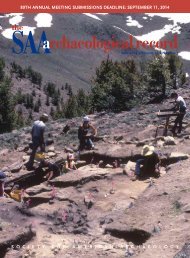SAA
Nov2016_web
Nov2016_web
Create successful ePaper yourself
Turn your PDF publications into a flip-book with our unique Google optimized e-Paper software.
IN MEMORIAM<br />
DOUGLAS W. SCHWARTZ<br />
1929–2016<br />
Douglas W. Schwartz, 86, died on June 29, 2016, in<br />
Santa Fe, New Mexico. Doug was president of <strong>SAA</strong><br />
from 1973 to 1974, received the <strong>SAA</strong>’s Distinguished<br />
Service Award in 1991, and received the American Anthropological<br />
Association’s Distinguished Service Award in 1992. He<br />
was an archaeologist and a champion of anthropological<br />
scholarship, but he was also a magician. Doug began practicing<br />
magic as boy in Kentucky, specializing in sleights of hand,<br />
and he never quite abandoned this early<br />
career, performing at various Santa Fe<br />
functions under the stage name “Dr.<br />
Magic.” Dr. Magic seems right for Doug<br />
Schwartz, because as the president of the<br />
School of American Research (now<br />
School for Advanced Research [SAR])<br />
from 1967 to 2001, he conjured up a<br />
place that was very real and yet fostered<br />
magical intellectual work.<br />
Schwartz received his doctorate from<br />
Yale in 1955 and was a faculty member at<br />
the University of Kentucky when he was<br />
selected to direct SAR, a keystone<br />
research center for southwestern anthropology<br />
in the first half of the twentieth<br />
century that that been reduced to a oneroom<br />
office without a clear purpose in<br />
the 1960s. From that nadir, Doug built a<br />
unique and widely admired (and imitated)<br />
campus through astute fund-raising,<br />
prescient planning, and a<br />
philosophical commitment to the idea<br />
that scholarship flourishes in an environment<br />
that combines opportunities for contemplation with<br />
the power of collective interaction. SAR matured through the<br />
latter half of the twentieth century from the initial gift of a private<br />
residence, adding residential housing for scholars, an inhouse<br />
press, and a world-class curatorial center for Native<br />
American arts. Now a coveted and prestigious destination for<br />
scholars, it is difficult to imagine that SAR was almost an historical<br />
footnote.<br />
Two of Doug’s first initiatives provided the backbone for this<br />
transformation. The Advanced Seminar Program brought<br />
groups of scholars to the SAR campus for a week of intensive<br />
interaction and uninterrupted collaborative work in the Seminar<br />
House, while the Residential Scholar Program provided<br />
fellowships for pre-doctoral and senior scholars. It is difficult<br />
to adequately calculate the impact these two programs have<br />
had for archaeology, with almost 100 archaeological seminars<br />
and dozens of scholars, but from these experiences have<br />
come some of the field’s seminal contributions (Elliott 1987;<br />
Scarborough 2005).<br />
Schwartz directed two major archaeological field programs at<br />
SAR. The first was a systematic survey and excavation in the<br />
Grand Canyon between 1967 and 1970, a collaborative effort<br />
with the National Park Service that produced<br />
the foundation for current interpretive<br />
models of Grand Canyon<br />
prehistory. Then, from 1971 to 1974, he<br />
directed a major excavation at Arroyo<br />
Hondo Pueblo, southeast of Santa Fe.<br />
Both projects were extensively documented<br />
in monographs, dissertations,<br />
and professional and popular articles. In<br />
the months before Doug died, he organized<br />
and chaired a series of seminar discussions<br />
around the continuing<br />
archaeological legacy of the Arroyo<br />
Hondo research.<br />
magic acts.<br />
Doug’s guidance at SAR created an<br />
organization to enhance anthropological<br />
understanding of the human story. A<br />
conjurer’s gift is making the difficult<br />
seem easy; Schwartz’s remarkable success<br />
at SAR belied an extraordinary<br />
amount of hard work, a rare talent for<br />
raising private funds, and the skill to<br />
manage a complex scholarly enterprise.<br />
It may be one of archaeology’s best ever<br />
References Cited<br />
Elliott, Malinda<br />
1987 The School of American Research: A History: The First Eighty<br />
Years. School of American Research Press, Santa Fe, New Mexico.<br />
Scarborough, Vernon L. (editor)<br />
2005 A Catalyst for Ideas: Anthropological Archaeology and the Legacy<br />
of Douglas W. Schwartz. School of American Research Press,<br />
Santa Fe, New Mexico.<br />
—W. H. Wills, Department of Anthropology,<br />
University of New Mexico<br />
November 2016 • The <strong>SAA</strong> Archaeological Record<br />
39




